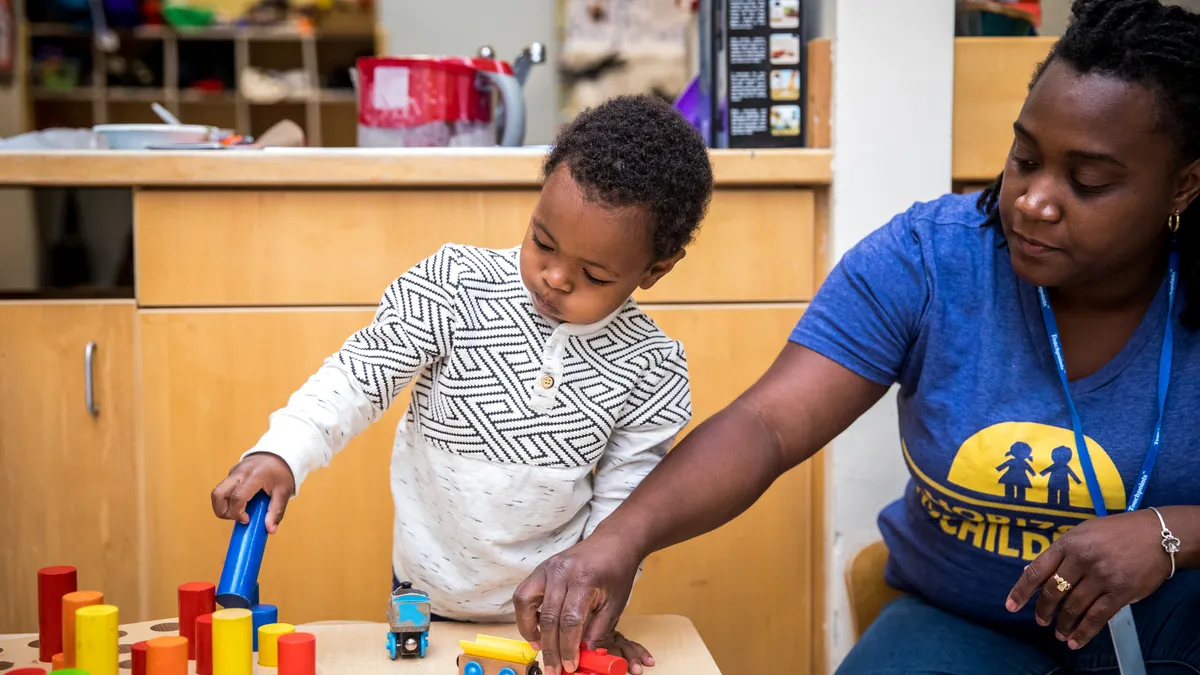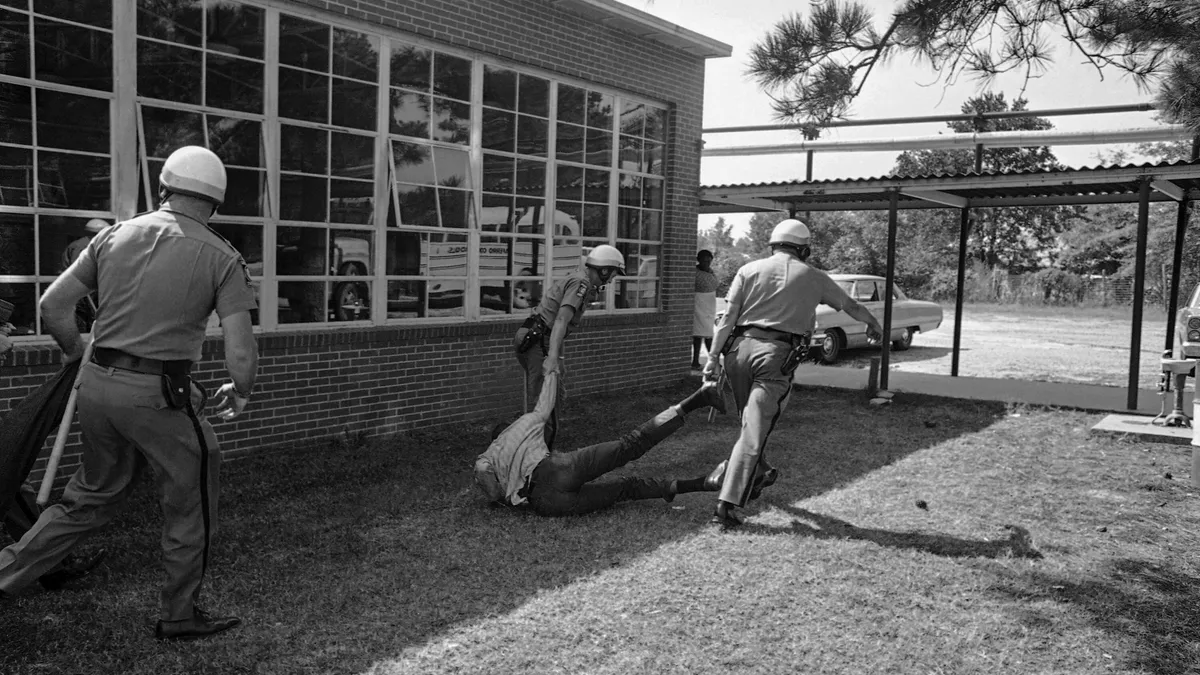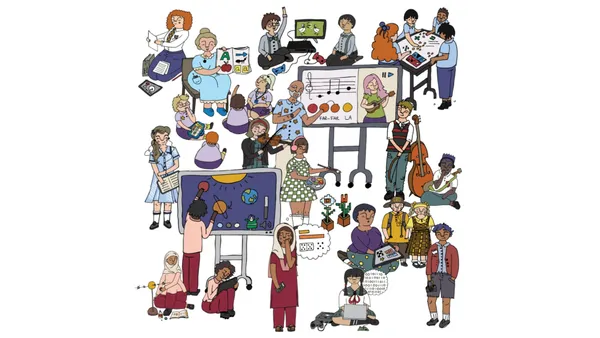Even among the infants and toddlers in her classroom, Meital Sandbank sees the effects of homelessness and living in a constant state of transition — difficulty self-soothing, an inability to follow directions and sometimes aggression.
“Children come in to school and their bodies are stressed,” Sandbank, who works at Horizons for Homeless Children — a Boston-area early learning provider and advocacy organization — wrote in an email. “Children who are constantly anxious or worried need much more support and one-on-one care to learn to cope and manage their emotions.”
Sandbank, however, is also participating with her colleagues in a new Certificate in Child Homelessness Studies program at Lesley University in nearby Cambridge, Massachusetts. The series of five courses — covering topics such as trauma, counseling and parent resilience — is designed to better prepare early educators to work with families in unstable living conditions.
“You don’t know when you walk into a classroom who has experienced homelessness. People don’t get trained,” Lesley professor Lisa Fiore said in an interview. She added that the new certificate program, which is designed for undergraduates who might pursue careers in education or counseling, is intended to raise awareness of how homelessness affects children.
More than 40 Lesley students have completed the certificate thus far, and roughly 1,000 have taken at least one of the courses, Fiore said. One student from Haiti, she noted, is a psychology major, but he took the courses because he returns to Haiti a few times a year and plans to begin a music therapy program.
From Horizons, 22 teachers are taking the courses in a cohort that also includes some individuals who work at the organization’s “playspaces” in shelters across the state. The partnership between the university and the nonprofit grew out of a request from the teachers, Wendy Kennedy, Horizons' education director, said in an interview.
“They really wanted some richer, deeper training and academic support,” Kennedy said. “Coming in the doors, our teachers are drawn to this work. but they know there is always more to learn.”
‘Why isn’t that required?’
While every child Horizons serves experiences homelessness, educators nationally are also increasingly seeing the effects of homelessness in their classrooms. According to the National Center on Family Homelessness at the American Institutes for Research, roughly 2.5 million children, including 1.2 million under age 6, experience homelessness each year.
Organizations, such as SchoolHouse Connection, provide resources, including research, state policy updates and webinars. Last week, for example, Barbara Duffield, the nonprofit’s executive director, participated in a webinar featuring experts on the issue of homelessness among young children as part of the Sesame Street in Communities initiative, which includes videos and materials on how to discuss tough topics — including divorce or a family member’s incarceration — with young children.
Barbara Duffield, the executive director of SchoolHouse Connection, participates in a panel of experts on child homelessness.
During the broadcast, Duffield described some signs educators might spot that should prompt them to further explore whether a child has a permanent address, including changes in behavior, hoarding food, falling asleep at unexpected times, and sudden or frequent absences. In fact, a recent policy brief from Poverty Solutions at the University of Michigan showed homeless students are the most likely to be chronically absent from school in that state.
Districts also provide professional development on homelessness. In the Los Angeles Unified School District, for example — where the number of homeless children increased by 50% from 2016 to 2017 — training includes how to identify homeless students and understand the rights and protections that apply under the McKinney–Vento Homeless Assistance Act.
But experts say there is also a growing need for beginning educators to understand some of the signs Duffield described, the challenges homeless families are facing, and how such trauma is manifested in children’s learning and behavior.
“Some in higher ed are … beginning to realize that teachers and school administrators are not prepared for the issues they must deal with at the district and school level,” Jan Moore, the assistant director of the National Center for Homeless Education, wrote in an email.
As part of a research study, Moore worked with another professor and a school social worker to deliver three courses on poverty, homelessness and trauma for the Masters of School Administration students at Western Carolina University. “We would like to do more of this work with other universities and in different formats,” she said.
In another example, Patricia Popp, the coordinator of Virginia’s homeless education program, Project HOPE, and a clinical associate professor in the William and Mary School of Education, weaves a discussion of highly mobile children into an elementary education classroom management course. She also includes a review of McKinney-Vento basics into a required Characteristics of Exceptional Populations course.
“I’ve had people say, ‘Why isn’t that required?’” she said in an interview. “I do think it’s a good foundation for everyone.”
‘It’s relationships’
At Horizons, Kennedy said there are some essential skills and knowledge early educators should have when working with children experiencing ongoing disruption. First, she said early educators should understand how trauma — and what Harvard’s Center on the Developing Child terms "toxic stress" — affect brain growth. When a young child’s body is constantly on alert, the frequent, elevated heart rate, blood pressure and stress hormone levels can lead to later health and learning problems. However, supportive relationships with caregivers, including early education providers, can help mitigate some of the effects of compound adversity.
“It sounds corny, but it’s relationships,” Popp added.
Second, teachers and early education providers “have to understand what they are bringing to the interaction” with parents and what might trigger a particular response, Kennedy said. It’s important that they are “valuing the parent as the expert of their child,” she said.
“We want the families to know that there isn’t a power hierarchy here.”
And third, it’s important for school administrators and program directors to watch for “compassion fatigue” in their teachers, Kennedy said, adding that Horizons leaders are receiving training in reflective supervision, in which leaders create opportunities for educators and caregivers to discuss the range of emotions and experiences they encounter in their work with families. “Self-care is something you often don’t think about,” she said.
The need for consistency and routines
Under the Every Student Succeeds Act, the McKinney-Vento law was expanded to include preschools administered by a school district. This means the rights K-12 students have to remain in their school of origin, even if they move out of those attendance boundaries — and to receive transportation to that site — are also extended to preschoolers in programs such as Head Start and Title I-funded classrooms. Because there are often waiting lists for preschool spots, a family moving in and out of a shelter or doubling up with other families or friends likely won’t be able to join a different class in the middle of the school year.
Such provisions are another way to provide some stability for children who don’t have it outside of the classroom.
“Where [young children] thrive is with consistency and with routines and with structure and with the devotion of caretakers,” Kate Barrand, president and CEO of Horizons for Homeless Children, said during the Sesame Street in Communities discussion. When children are homeless, she added, they “lose that consistency. They lose the routine that really allows their brains to develop.”
Barrand also identified some issues school administrators might see among children entering kindergarten or public pre-K, such as developmental delays. And Karen Hudson, a community relations adviser with the Children’s Hospital of Philadelphia, said children’s immunizations might not be up to date, and they might be overweight if their diet is primarily made up of fast food because they're living in a motel. To address absenteeism among older students, some schools have been installing laundry facilities.
Other practical advice for educators and early-childhood program directors is to form relationships with motel managers and to be careful how enrollment forms are worded, avoiding the term homeless.
“You’d be surprised how insensitive forms can be,” said Marsha Basloe, formerly the senior adviser for the Office of Early Childhood Development at the Administration for Children and Families, within the U.S. Department of Health and Human Services.
In that position, she developed a self-assessment tool that administrators and program leaders can use over time to evaluate how they’re already serving families who are homeless — or could potentially become homeless — and where improvements are needed. Now, as president of the Child Care Services Association, a resource and referral agency in Durham, North Carolina, she will continue to share the tool with faculty members of the North Carolina Community College System at two meetings next year.
‘Learning from each other’
Sandbank, at Horizons, said she had long been interested in working with “more vulnerable populations of children.” And she did a lot of reading on how trauma and adversity affect brain development in a young child. Now, she said, she has the added benefit of learning with her peers.
“We are all working together and sharing our experiences and then learning from each other as we implement in our early-education classrooms,” she said. “Their experience is teaching me new ways to handle difficult situations.”







 Dive Awards
Dive Awards







